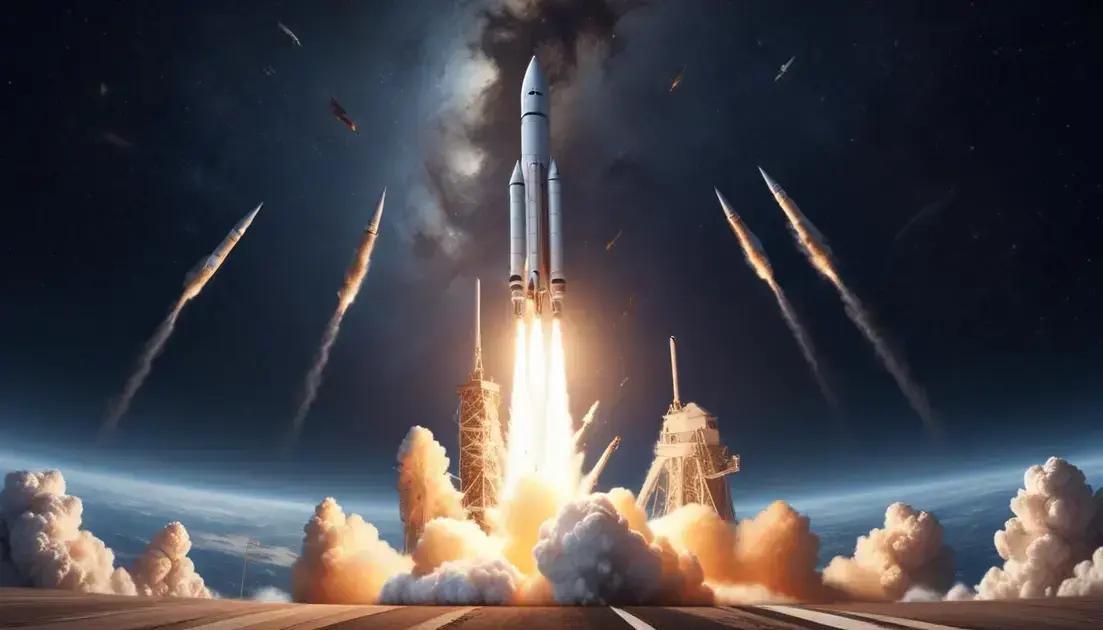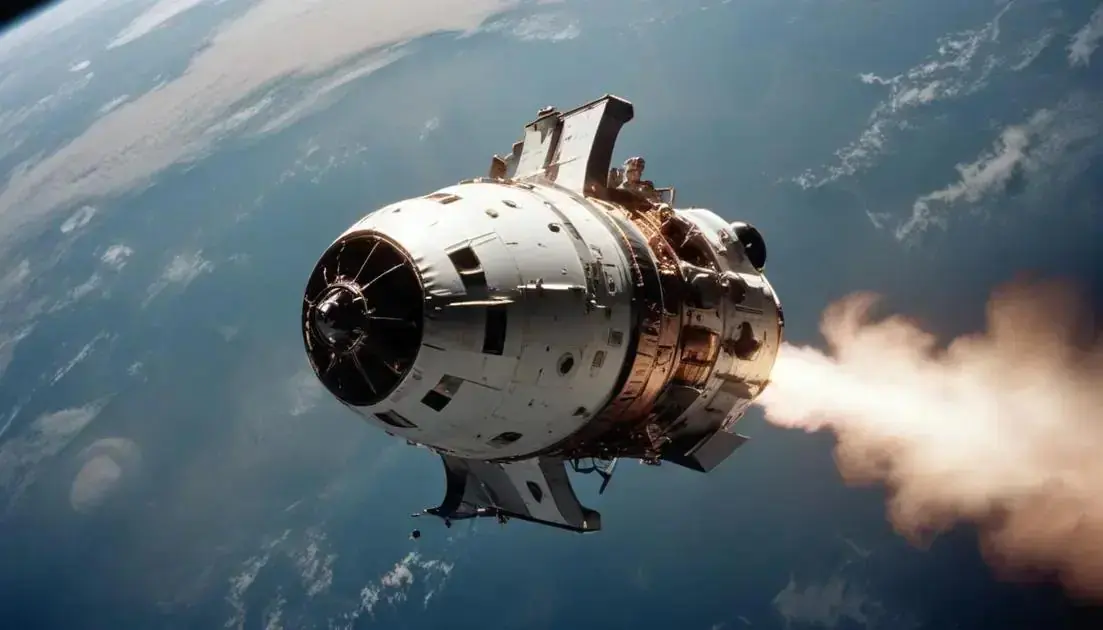
Space Race: From Earth to Moon in the Name of Ideology
The Space Race significantly impacted technology and global cooperation. It spurred innovations in rocketry, telecommunications, and computing, shaping modern life. Furthermore, it inspired future generations to pursue careers in science and engineering. The legacy includes new collaborations, exemplified by the International Space Station, demonstrating the benefits of nations working together towards common goals in space exploration.
The Space Race marked an exhilarating chapter in history, igniting fierce competition fueled by ideological differences. Curious about how this rivalry shaped science and technology? Let’s dive in!
The Origins of the Space Race
The Space Race began in the late 1940s, right after World War II. It started as a competition between the United States and the Soviet Union. Both nations wanted to prove their strength and technological prowess.
This race became famous for its key events, like the launch of the first artificial satellite, Sputnik, by the Soviet Union in 1957. It shocked the world and made many Americans worried about falling behind.
The U.S. responded by ramping up its space efforts. NASA was founded in 1958 to coordinate these missions. They wanted to show that they could match the Soviets. This led to exciting moments, like the Mercury and Gemini programs, all aimed at sending humans into space.
The Political Climate
The Cold War added to the intensity of the Space Race. The world was divided between the capitalist West and the communist East. Each side wanted to showcase its ideology through space achievements.
For many, space exploration symbolized freedom and technological advancement. It was not just about science; it was about national pride and prestige.
Scientific Breakthroughs
Throughout this competition, numerous scientific breakthroughs emerged. Both countries developed new technologies that would later benefit everyday life, such as advancements in communications, materials science, and even computer technology.
The Space Race wasn’t just about winning; it was about pushing the boundaries of what was possible in science and technology.
Key Milestones in Space Exploration
Several key milestones shaped space exploration and defined the Space Race. These events helped us learn more about space and our place in it.
One major milestone was the launch of Sputnik 1 by the Soviet Union in 1957. It was the first artificial satellite to orbit the Earth. This event shocked many in the U.S. It proved that the Soviets had advanced technology and sparked fear of falling behind.
Then came the U.S. response. In 1961, President John F. Kennedy set a bold goal to land a man on the Moon. This vision was part of a larger strategy to win the Space Race.
The Mercury program was launched to send Americans into space. The first astronaut, Alan Shepard, flew in 1961. This flight lasted only 15 minutes but marked a huge step forward.
The Gemini Program
Next, the **Gemini program** followed. It allowed astronauts to stay in space for longer and conduct important tasks. This laid the groundwork for future missions. Astronauts learned how to dock space capsules and conduct spacewalks.
Landing on the Moon
Finally, the Apollo 11 mission in 1969 achieved what many thought was impossible. Neil Armstrong and Buzz Aldrin became the first humans to walk on the Moon. This event captivated the world and marked a huge win for the U.S.
These milestones show how quickly we advanced in space technology during the Space Race. They highlight human courage and the drive to explore beyond our planet.
Ideological Underpinnings: Capitalism vs. Communism
The Space Race was not just about rockets and satellites. It was also about two very different ideologies: capitalism and communism. These two systems shaped the goals and actions of the United States and the Soviet Union.
In capitalism, freedom and competition drive progress. The U.S. saw space exploration as a way to showcase its technological strength. They believed that innovations in space would show the benefits of a capitalist society. This system encouraged private companies to contribute to space missions.
On the other hand, communism emphasizes state control and equality. The Soviet Union launched its space program to prove that their system was superior. They aimed to demonstrate that a planned economy could achieve great scientific achievements, such as sending the first human into space.
Propaganda and National Pride
Both nations used space achievements as propaganda tools. Each sought to promote its ideology and way of life. When Russia launched Sputnik, it became a source of pride for communism. The U.S. felt pressure to respond and reaffirm its place in the world.
Scientific Advancements
Despite their differences, both systems led to major scientific advancements. They encouraged a spirit of exploration and discovery. As they pushed each other, both countries developed technologies that still benefit us today.
This competition brought about innovations in communication, materials, and even computer technology. So, while they fought ideologically, they also made strides that would change the world.
Impact of the Space Race on Technology
The Space Race greatly impacted technology in many ways. Its competition pushed scientists and engineers to work faster and smarter. New inventions changed everyday life, and some are now part of our daily routines.
One major breakthrough was in rocket technology. As both the U.S. and the Soviet Union raced to send rockets into space, they developed powerful engines and materials. These improvements helped make space travel safer and more efficient.
Another area that got a boost was satellite technology. The launch of satellites allowed for better communication and weather forecasting. Now, we rely on satellites for GPS navigation and television broadcasts.
Advancements in Computer Technology
The Space Race also spurred advancements in computer technology. To send astronauts into space, engineers needed better computers. This created a push for more powerful and smaller machines.
Additionally, the Space Race led to developments in miniaturization, which set the stage for modern electronics. Today, many devices we use, like smartphones and tablets, owe their existence to these advances.
Materials Science Innovations
Innovations in materials science happened too. Researchers created new materials for use in harsh environments, like space. These materials are now used in various industries, including healthcare and construction.
Overall, the Space Race didn’t just lead to reaching the Moon. It set the foundation for countless technological advancements that we benefit from today.
The Legacy of the Space Race Today
The Space Race left a lasting legacy that we still feel today. Its impact goes beyond rockets and satellites. It changed our view of science, technology, and even international relations.
One major aspect of this legacy is the spirit of exploration. People became more curious about space and science. NASA and other organizations work hard to educate the public about space travel, scientific research, and astronomy.
Commercial spaceflight is another important development. Companies like SpaceX and Blue Origin are now pushing for new adventures in space. They have made space more accessible and affordable for both research and tourism.
Technological Advancements
The technology developed during the Space Race continues to influence our lives. Innovations in materials, computing, and telecommunications shape many aspects of modern life. From smartphones to medical devices, many advancements trace back to that era.
Global Cooperation
The Space Race also opened doors for international cooperation. Today, countries often work together on space missions. The International Space Station (ISS) is a prime example of this collaboration. Countries came together to create a shared space environment for research.
This cooperation promotes peace and understanding between different nations, showing that we can achieve great things when we work together.
Lastly, the Space Race has inspired generations of scientists and engineers. It sparked interest in STEM (Science, Technology, Engineering, and Math) fields. Many young people today pursue careers in these areas because of that inspirational period.
Conclusion
In conclusion, the Space Race played a crucial role in shaping our world today. It sparked innovations in technology and inspired generations to explore the unknown. The legacy of this competition goes beyond mere space travel; it fosters a spirit of curiosity and collaboration.
From advancements in telecommunications to international partnerships like the ISS, we see the lasting impact of the Space Race everywhere. It reminded us that great achievements come from the desire to explore and work together. As we look to the future, we should carry this spirit of innovation and teamwork into new frontiers, continuing the quest for knowledge and discovery.


